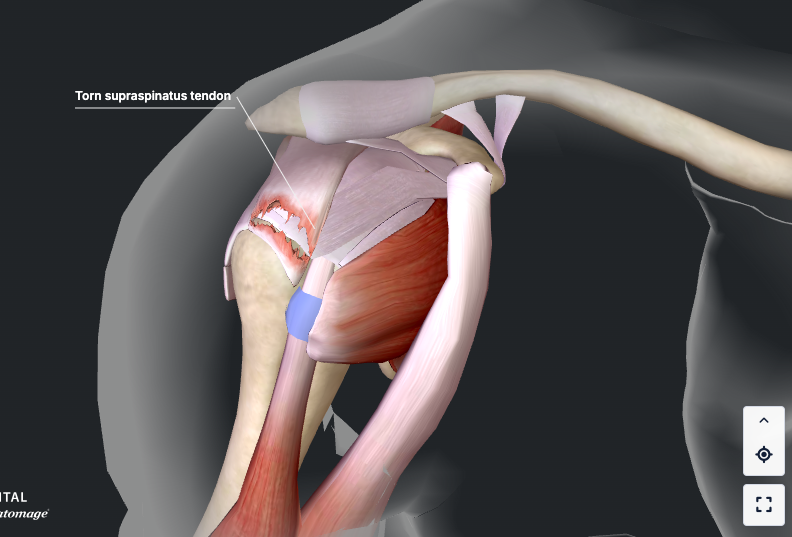
Rotator Cuff Tears
Education
Rotator Cuff Tears
The rotator cuff is a group of four muscles and their tendons that surround the shoulder joint, keeping the head of the humerus (upper arm bone) firmly within the shallow socket of the shoulder blade (glenoid). These muscles allow you to lift and rotate your arm and help stabilize the shoulder during overhead and athletic movements.
A tear in the rotator cuff is a common source of shoulder pain and dysfunction, especially in middle-aged and older adults or athletes who perform repetitive overhead motions.
Rotator Cuff Anatomy
The rotator cuff consists of four muscles:
Supraspinatus: Most commonly torn; lifts the arm.
Infraspinatus and Teres Minor: Help with external rotation.
Subscapularis: Assists with internal rotation.
These tendons blend into a single cuff that wraps around the humeral head. Tears may involve one or more tendons and can be partial or full-thickness.
Types of Rotator Cuff Tears
Rotator cuff tears can vary in size, pattern, and chronicity:
Partial-thickness tear: The tendon is damaged but not completely severed.
Full-thickness tear: The tendon is completely detached from the bone.
Degenerative tears: Result from wear and tear over time.
Acute tears: Typically due to trauma, such as a fall or heavy lifting.
What Causes Rotator Cuff Tears?
Tears may develop from:
Repetitive overhead activity: Common in athletes (e.g., baseball, tennis) and certain occupations.
Trauma: Falling on an outstretched arm or lifting something heavy.
Age-related degeneration: Natural tendon wear, especially after age 40.
Poor shoulder mechanics: Can contribute to impingement and progressive tearing.
Symptoms of a Rotator Cuff Tear
Symptoms can range from mild to severe and may include:
Pain at rest or during movement, especially with overhead activity
Weakness or difficulty lifting the arm
Clicking, popping, or catching in the shoulder
Night pain, especially when lying on the affected side
Limited range of motion
Diagnosis
Diagnosis involves a detailed evaluation:
Physical examination: Includes strength testing and provocative maneuvers.
Imaging: MRI is the gold standard for evaluating tear size, tendon retraction, and muscle quality. Ultrasound is a cost-effective alternative in some cases.
X-rays: Helpful to rule out arthritis or other structural issues.
Understanding the type and extent of the tear is key to developing an individualized treatment plan.
Treatment Options
Treatment depends on the size and type of tear, symptoms, activity level, and overall shoulder function.
Non-Surgical Treatment:
Effective for partial tears or small full-thickness tears without significant weakness.
Includes physical therapy, anti-inflammatory medications, and activity modification.
Cortisone injections may offer temporary pain relief.
Surgical Treatment:
Rotator Cuff Repair: Reattaches the torn tendon to the bone using suture anchors. Can be performed arthroscopically in most cases.
Tissue Augmentation: Biologic patches or PRP may help in challenging cases.
Superior Capsular Reconstruction or Tendon Transfer: Considered for massive, irreparable tears in select patients.
Surgery aims to restore shoulder strength, reduce pain, and prevent further tendon degeneration.
Recovery and Outlook
Non-Surgical:
Gradual return to activity over weeks to months.
Ongoing shoulder strengthening to support function.
Surgical:
Initial period of immobilization (typically 4–6 weeks).
Physical therapy focuses on restoring range of motion, then strength.
Most patients return to full activity by 4–6 months, though overhead athletes may require longer rehabilitation.
Conclusion
Rotator cuff tears are a common cause of shoulder pain and dysfunction but can be effectively treated with a combination of rehabilitation and, when needed, surgical repair. Timely diagnosis and personalized care help preserve shoulder function and improve quality of life.
If you’re experiencing shoulder pain, weakness, or difficulty with overhead activity, we encourage you to schedule a consultation for a comprehensive evaluation and treatment plan tailored to your goals.

